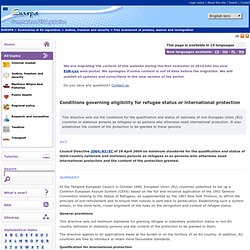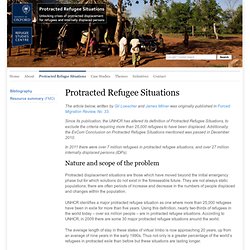

UNHCR Statistical Yearbooks. Iraq. | Overview | Working environment Internal sectarian tensions and divisions are still polarizing Iraq, while the crisis in the Syrian Arab Republic (Syria) continues to feed instability in the region.Iraq is not only receiving large numbers of Syrian refugees, but is also seeing the return of many Iraqi refugees, particularly from Syria.

Often these returnees cannot go back to their places of origin, leading to new secondary displacement inside Iraq.With the growing number of Syrian refugees putting additional strains on local infrastructure and essential services, which were already significantly weakened by the years of war and instability, access to basic services for the Iraqi population itself remains problematic. Stagnant socio-economic development further affects daily life in Iraq, while institutional capacity remains limited. These conditions hamper the ability of internally displaced people to return home.
Conditions governing eligibility for refugee status or international protection. At the Tampere European Council in October 1999, European Union (EU) countries undertook to set up a Common European Asylum System (CEAS) based on the full and inclusive application of the 1951 Geneva Convention relating to the Status of Refugees, as supplemented by the 1967 New York Protocol, to affirm the principle of non-refoulement and to ensure that nobody is sent back to persecution.

Establishing such a system entails, in the short term, closer alignment of the rules on the recognition and content of refugee status. General provisions This directive sets out minimum standards for granting refugee or subsidiary protection status to non-EU country nationals or stateless persons and the content of the protection to be granted to them. The directive applies to all applications made at the border or on the territory of an EU country. In addition, EU countries are free to introduce or retain more favourable standards. Background on Refugees. Refugees The U.N.

High Commissioner for Refugees (UNHCR) defines a refugee as someone who is outside their country of nationality for fear of being persecuted for their race, religion, nationality, or membership of a particular social group or public opinion and, because of this fear, is unwilling to appeal for protection in that country. Basics The number of people uprooted by conflict and persecution is at its highest in 18 years.At the end of 2012, 45.1 million people worldwide were forcibly displaced as a result of conflict and persecution. 15.4 million of these people are refugees.Along with refugees, there are also asylum seekers, who are those who claim to be refugees, but have not had their claim evaluated. There are also Internally Displaced People (IDPs). RSCSumUpdate11.pdf (application/pdf Object) [12 Nov 1998] GA/SHC/3506 : HEAVY BURDEN BORNE BY COUNTRIES FACING SUDDEN MOVEMENTS OF REFUGEES AMONG ISSUES DISCUSSED BY THIRD COMMITTEE.
12 November 1998 Security of Humanitarian Workers, Abduction of Vincent Cochetel also Addressed by Speakers The heavy burden borne by some countries, especially developing countries, in dealing with sudden movements of large numbers of refugees across their borders was among the issues raised as the Third Committee (Social, Humanitarian and Cultural) continued this morning its consideration of questions relating to refugees and displaced persons and humanitarian questions.
![[12 Nov 1998] GA/SHC/3506 : HEAVY BURDEN BORNE BY COUNTRIES FACING SUDDEN MOVEMENTS OF REFUGEES AMONG ISSUES DISCUSSED BY THIRD COMMITTEE](http://cdn.pearltrees.com/s/pic/th/countries-movements-discussed-30247167)
The representative of New Zealand said countries of first emergency asylum played a major part in humanitarian relief efforts for refugees, sometimes over a very long period and with very few resources. In some such affected countries, a prolonged influx of refugees had led to a breakdown in the domestic infrastructure. The representative of Pakistan said that in most cases, the countries hosting large refugee populations were, mainly by "accident of geography", developing countries with fragile economies. Statements. Africa Proximity of refugee locations to international Borders. 46934d4f2.pdf (application/pdf Object)
South Africa. Refugee Studies Centre, Oxford — Gil Loescher. Biography Gil Loescher is Visiting Professor at the Refugee Studies Centre.

He is a long-established expert on international refugee policy. Protracted Refugee Situations: Understanding and addressing the challenge: Home. Protracted Refugee Situations: Understanding and addressing the challenge: Protracted Refugee Situations. The article below, written by Gil Loescher and James Milner was originally published in Forced Migration Review, No. 33.

Since its publication, the UNHCR has altered its definition of Protracted Refugee Situations, to exclude the criteria requiring more than 25,000 refugees to have been displaced. Additionally, the ExCom Conclusion on Protracted Refugee Situations mentioned was passed in December 2010. In 2011 there were over 7 million refugees in protracted refugee situations, and over 27 million internally displaced persons (IDPs). Nature and scope of the problem Protracted displacement situations are those which have moved beyond the initial emergency phase but for which solutions do not exist in the foreseeable future. The significance of protracted refugee situations - The Adelphi Papers - Volume 45, Issue 375. Protracted refugee populations not only constitute over 70% of the world's refugees but are also a principal source of many of the irregular movements of people around the world today.

The long-term presence of refugee populations in much of the developing world has come to be seen by many host states in these regions as a source of insecurity. In response, host governments have enacted policies of containing refugees in isolated and insecure camps, have prevented the arrival of additional refugees and, in extreme cases, have engaged in forcible repatriation. Not surprisingly, these refugee populations are also increasingly perceived as possible sources of insecurity for Western states. Refugee camps are sometimes breeding grounds for international terrorism and rebel movements. These groups often exploit the presence of refugees to engage in activities that destabilise not only host states but also entire regions.
The long road home: Protracted refugee situations in Africa - Survival - Volume 47, Issue 2. Protracted refugee situations are a critical and growing element in continuing conflict and instability, especially in Africa.

Such situations can result in direct security concerns, including the presence of armed elements within the refugee population and the spill-over of conflict across borders, and indirect security concerns, as tensions rise between local populations and refugees over the allocation of scarce resources. Somali refugees in Kenya and Burundian refugees in Tanzania constitute two of the most challenging protracted refugee situations in Africa. The overall response to protracted refugee situations remains fragmented, compartmentalised and ineffective. What is required is a new policy agenda that extends beyond conventional boundaries and seeks to integrate the resolution of chronic and recurring regional refugee problems with economic development and security issues. Related articles View all related articles. Refugee camp. A refugee camp is a temporary settlement built to receive refugees.

Camps with over a hundred thousand people are common, but as of 2012 the average camp size is around 11,400.[1] Usually they are built and run by a government, the United Nations, or international organizations, (such as the Red Cross) or NGOs. Some refugee camps exist for decades and people can stay in refugee camps for decades, both of which have major implications for human rights.
Some camps grow into permanent settlements and even merge with nearby older communities, such as Ein el-Helweh and Deir al-Balah. Refugee camps may sometimes serve as headquarters for recruitment, support and training of guerrilla organizations engaged in fighting in the refugees' country of origin, often using humanitarian aid to supply their troops.[2] Rwandan refugee camps in Zaire[3] and Cambodian refugee camps in Thailand[4] supported armed groups until their destruction by the military. Facilities[edit] Duration[edit] See also[edit] Refugees International. Forced Migration Review - Displaced persons camp. Class portrait of school children at Schauenstein DP camp, about 1946 A displaced persons camp or DP camp is a temporary facility for displaced persons threatened into forced migration.

Refugee trends: Lost in limbo. Africa: The forgotten conflict. By Tim Judah in Tindouf, south-western Algeria When one country invades another or a war starts we generally get to hear about it. Kuwait, Iraq, Bosnia, Kosovo ... Western Sahara? The World's Largest Refugee Camp Turns 20 - In Focus. Surrounding the small town of Dadaab, Kenya, is one of the oldest and largest refugee camps in the world, now home more than 332,000 people, mainly from Somalia.
(It was originally designed to house just 90,000.) The complex of camps was first established as a temporary solution more than 20 years ago by the United Nations High Commission for Refugees (UNHCR), after Somalia descended into a civil war that continues to this day. According to UN estimates, more than 31,000 additional Somalis have arrived in the camps this year alone, as drought and continuing violence between Somali Government forces and Al-Shabaab militants have forced them to seek long-term refuge. To deal with overcrowding, sanitation, and health problems, UNHCR officials were looking to expand the complex by opening a fourth camp, but Kenyan authorities have frozen the plan due to security concerns. These photos offer a view into life in Dadaab. [32 photos] Use j/k keys or ←/→ to navigate Choose: A U.S. U.N. India's forgotten refugees who wait for justice after 60 years. 'We first came here as refugees in 1947,' says Kajal Roy, his eyes watering from the smoke that fills his bamboo and mud home. 'We used cow dung for fuel then, as we do now.
Nothing has really changed for us. When we fled from East Bengal to West Bengal 60 years ago, our land in the camp was marked out by a few pebbles: 20 square feet a head. Bhutanese Refugees - The story of a forgotten people. Many of the images and text used on this website have been created by young people living in the Bhutanese refugee camps and participating in the The Bhutanese Refugee Children's Forum ‘I use my pictures to show Bhutanese people are kind, loyal and speak the truth. It is the only medium through which I can focus all my feelings about living a refugee life. Through this project I have come to understand the real objectives of taking photos. Burma refugees in Malaysia – no choice, no voice! There are currently over 140,000 refugees in camps along the Thai /Burma border. Many of these people have been there for over 20 years and are unlikely to return to Burma under the present military regime.
These refugee camps represent one of the world’s longest running humanitarian crises. Burma, in fact, has been ranked as the world’s third largest source of refugees after Afghanistan and Iraq. However, the Thai / Burma border is not the only place you will be confronted with people who have been forced to flee political, ethnic and religious persecution in Burma. Burundi Refugees ~ Burundi War Refugees. Protracted refugee situations: Millions caught in limbo, with no solutions in sight.
Protracted Refugee Situations. Protracted Refugee Situations. Globalization of Protracted Refugee Situations, Kenyan case study, PRIO project. Palestine refugee camps. Palestine refugee camps were established after the 1948 Arab–Israeli War to accommodate the Palestine refugees who fled or were expelled during the 1948 Palestinian exodus. United Nations General Assembly (UNGGA) Resolution 194 grants Palestinians the right to return to their homeland if they wish to "live at peace with their neighbors".
The United Nations Relief and Works Agency for Palestine Refugees in the Near East (UNRWA) defines a Palestine refugee as: Union Aid Abroad APHEDA: Overseas Projects: The Middle East. Home Overseas Projects. June 20, 2008 ~ Palestinian Refugee Camps in Lebanon.